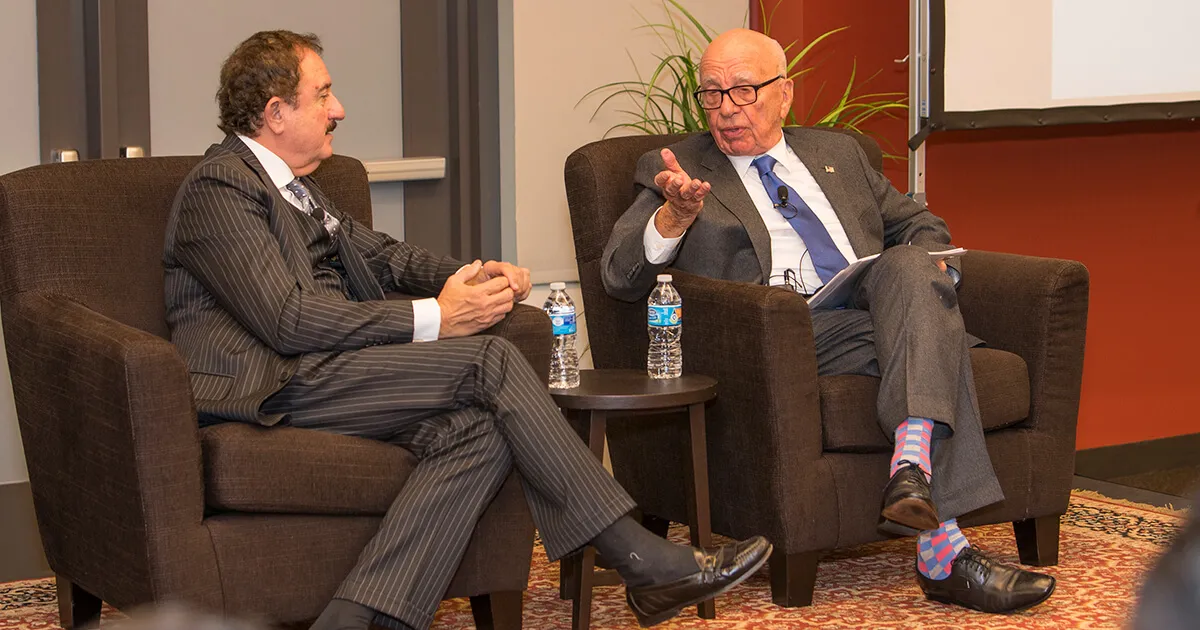State of Latino Entrepreneurship Conference: Encouraging Signs of Growth Despite Scaling Challenges
Rupert Murdoch notes positive impact of Latino-owned businesses at Jan. 18 State of Latino Entrepreneurship Event
January 26, 2017

Sol Trujillo and Rupert Murdoch discuss the findings of the State of Latino Entrepreneurship report and its implications to the U.S. economy. | Stacy Geiken
Latino-owned businesses are a driving force in the American economy, increasing in number even faster than non-Latino companies over the last decade. But companies owned by Latinos still struggle to gain access to capital and to expand enough to generate at least $1 million in annual revenue.
These are among the findings of a report entitled State of Latino Entrepreneurship 2016, produced by the Stanford Latino Entrepreneurship Initiative, a research initiative housed at Stanford Graduate School of Business in collaboration with the Latino Business Action Network.
The results included survey responses from more than 4,900 companies and were presented Jan. 18 at Stanford GSB, at a conference that attracted about 200 academics, current students and alumni, members of the press, and prominent business people including Executive Chairman of News Corp. Rupert Murdoch.
Entrepreneurship is in the lifeblood of Latinos in the United States, according to Sol Trujillo, former CEO of Telstra Corp., Australia’s largest telecommunications and media company based in Melbourne. Trujillo and Murdoch shared a stage to discuss the research findings and implications to the U.S. economy.
Murdoch told the audience the strong institution of the Latino family is a great asset that can help launch and support entrepreneurial endeavors. Trujillo said about one in four Latino families is already engaged in such activities and that family backing should help in the creation of a strong backbone, both said.
“One of the most important qualities for an entrepreneur is the willingness to take risks,” Trujillo said, noting Murdoch’s career has included risk-taking endeavors.
“Entrepreneurship is the fundamental way to create opportunity for everyone,” Murdoch said. “We are lucky to be in the United States, the best place in the world for entrepreneurship.”
He said access to high-quality education, and later to capital for the start-up and growth phases of a business, are the top challenges for the Latino community. Both he and Trujillo said small businesses, which make up the bulk of those owned by Latinos, are the economy’s biggest job generators.
“There are two very powerful realities about the Latino community in the United States,” said Jerry Porras, co-faculty director of the Stanford Latino Entrepreneurship Initiative and Lane Professor Emeritus of Organizational Behavior and Change at Stanford GSB. “One is that the percentage of the [Latino] population nationally is growing rapidly, from 17 percent today to 30 percent by 2050. The other reality is that Latino-owned businesses already are growing and providing jobs for the American labor force, and that will only become a bigger part of our economy.”
“In order to insure that impact it is positive,” Porras added, “the Latino community needs to leverage its contribution with an increase in income and wealth. The quickest way to accelerate these is through entrepreneurship. Stanford having been a national leader in educating and developing entrepreneurs coupled with its location in California and the Silicon Valley, is in a prime position to play a significant role in promoting Latino entrepreneurism.”
Porras, who established the Latino Business Action Network, a 501(c)(3) nonprofit, in 2012 with a group of Stanford alumni, said there are now an estimated 4 million Latino-owned businesses throughout the United States. The group also offers the Stanford Latino Entrepreneur Leaders Program, a six-week executive education program that teaches entrepreneurs how to successfully scale their businesses. It includes modules from Stanford GSB professors such as Hayagreeva (Huggy) Rao, Atholl McBean Professor of Organizational Behavior and Human Resources.
Despite their rapid proliferation in numbers — 300,000 new businesses created during the mostly recessionary period from 2007 to 2012 — Porras said many Latino-owned businesses struggle to expand, or “scale.” Only 2 percent reach the $1 million mark in annual revenue and have at least 50 employees.
To scale successfully, Porras recommends stronger educational and support programs for budding entrepreneurs, expanding research to establish large and complex databases, and for already established business owners to do business with each other. Porras said he recently spoke with a Latina entrepreneur who had opened a new winery in Napa Valley. Through networking, she met an owner of a regional chain of supermarkets in Los Angeles and an owner of a small chain of restaurants in San Francisco. Both owners of the grocery store and restaurant chains now plan to sell or serve the new winery’s products, Porras said. Connecting those types of entrepreneurs with each other is one of the goals of the collaboration.
For media inquiries, visit the Newsroom.
Explore More
Maker: United Record Pressing

Phil Knight Honored with Uncommon Citizen Award

Catherine Roberts Joins Stanford GSB as CCMO
